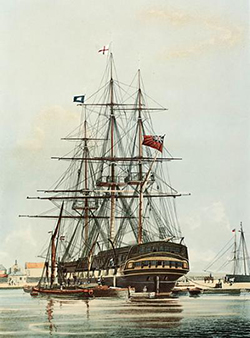Catherine PATTESON ??? - 1838
Married 5th June 1838 at Shaftesbury St James, Dorset, to Dr. Arthur Benoni EVANS 1813 - 1838
Died 17th October 1838, at sea
Catherine's story
Marriage Certificate
At first sight we know nothing at all about Catherine but I feel she deserves some sort of recognition, hence this short account. With the little we have to go on, the following emerges.
She is the daughter of Rev. William PATTERSON who officiates at the young couple’s wedding ceremony in June 1838. The parish of St James, Shaston, is its own small village under the hill south of the town, the oldest part of Shaftesbury, Dorset.
We can imagine this happy occasion surrounded by friends and family.
Her young doctor husband had completed his training and was committed to serving in India. She would have taken on the commitment of being a doctor’s wife. They were both in their twenties and had much to look forward to. It must have been with mixed feelings of adventure, excitement, and anxiety as they faced leaving England for their time in India. From the beginning of their marriage their minds would have focussed on the packing of trunks and preparing for their adventurous journey.
Before 1830, passengers bound for the East had no alternative but to circumnavigate Africa; the journey could take six months. In that year the East India Company pioneered the Red Sea route with a small steamer, built in India, called the Hugh Lindsay. From 1835 the mail for India could be sent through the Middle East rather than around the Cape. In 1837, the Company started a steam packet service between Bombay and Suez with the paddlers Berenice and Atalanta. The average journey time from India to Britain was reduced from six months to two.
By 1838 the connection across the Middle East was still suitable only for passengers and mail.
Passengers sailed to the port of Alexandria, on the Mediterranean. Then by a tiny paddle steamer went up the Mahmoudieh Canal, then up the Nile in the Jack O'Lantern. Next there was an awkward trip by horse-drawn wagon 84 miles across the desert from Cairo to Suez. Passengers then boarded their ship and sailed down the Gulf of Suez. They would have then crossed the Arabian Sea, sailed around the South of India and then northwards on the Bay of Bengal.
Their ship the East Indiaman (The Protector) was typical of the time – a fine sailing vessel but would have been cramped and awkward by today’s standards. We know nothing about the voyage until the ship carrying Arthur and Catherine, reached Sagar Roads, India - the navigable entrance at the mouth of the Hugli River, which lies about 2 miles W of the SW extremity of Sagar Island. The navigable entrance channel leading to Sagar Roads is subject swift currents and to change in position and direction to accompany the change in depths. Local knowledge and assistance is essential to safe navigation.
Hugli River, Hugli also spelled Hooghly, river in West Bengal state, is an arm of the Ganges. It provides access to Kolkata (Calcutta) from the Bay of Bengal.
Tragedy
Arthur and Catherine would probably have been able to make out the low-lying land of Begal. But something goes wrong, and they are wrecked with the loss of 170 of the 178 people on board.
One can only imagine the horror as the ship lists and goes down. Arthur as a doctor would have wanted to help in whatever way he could, but he would have also been protective of his young wife. Together they drown in the silty waters.
News of the tragedy would only reach home some two months later.
An East Indiaman ship of the time.
For further reading see ‘Passage East’ by Ian Marshall, Howell Press

